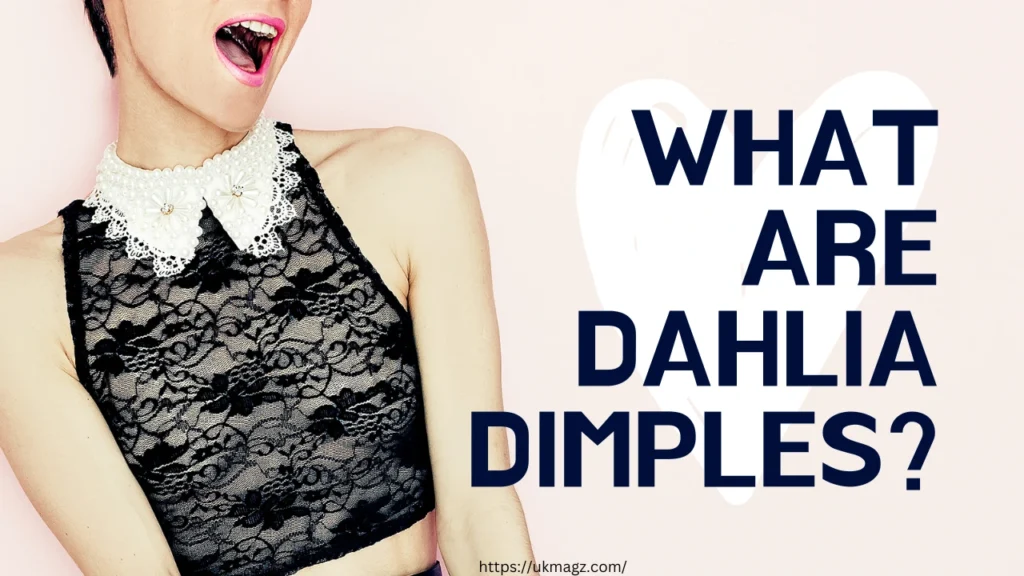
Dahlia dimples are a unique facial feature that has gained popularity in recent years, especially in the realms of beauty and aesthetics. Named after the Dahlia flower due to their petal-like indentation, these dimples are not only rare but also considered highly attractive. While many people seek to enhance their facial features through cosmetic treatments to achieve dahlia dimples, others naturally possess them, adding to their charm. In this article, we’ll explore everything you need to know about dahlia dimples, from their origins to ways to enhance and embrace them.
You May Like: Aliza Barber
What Are Dahlia Dimples?

Dahlia dimples are small indentations located at the corners of the mouth, often referred to as “mermaid dimples” or “angel kisses.” They form due to a unique contraction of facial muscles, particularly the zygomaticus major muscle. When this muscle contracts, it creates a small indentation in the skin, similar in appearance to the petals of a dahlia flower. Unlike traditional cheek dimples, which form higher up on the face, dahlia dimples are positioned near the mouth, giving them a distinct look.
The Genetic Component of Dahlia Dimples
Dimples, in general, are considered to be a dominant genetic trait. This means that if one parent has dimples, there is a higher chance their child will inherit them. However, dahlia dimples specifically are relatively rare, and not everyone with dimpled parents will develop them. While traditional cheek dimples are more commonly seen, the placement and shape of dahlia dimples make them more unique Flower Pursuits.
Why Are Dahlia Dimples Desirable?
The rise in the popularity of dahlia dimples can be attributed to their charming, youthful appearance. They are often associated with a natural beauty that enhances facial symmetry. For many, these dimples make the face look more approachable and lively, adding a unique aspect to one’s smile.
Additionally, because dahlia dimples are uncommon, those who possess them are often seen as having a distinctive feature, further boosting their appeal in aesthetic circles ShunCy.
The Difference Between Dahlia Dimples and Smile Lines
It’s easy to confuse dahlia dimples with smile lines, but they are different in both their origin and appearance. Smile lines, also known as nasolabial folds, are shallow wrinkles that appear around the eyes and mouth when a person smiles. Dahlia dimples, on the other hand, are natural indentations near the corners of the mouth, more pronounced when smiling but visible even at rest.
Understanding the difference between these two features can help in identifying whether someone has smile lines due to aging or dahlia dimples, which are more permanent Flower Pursuits.
How to Enhance Dahlia Dimples Naturally
For those not born with dahlia dimples, there are non-surgical ways to enhance the appearance of these dimples. Simple facial exercises can help emphasize the muscles that form dimples. Here’s a method you can try:
- Smiling Exercise: Smile widely while keeping your lips closed. Press your fingers gently into the corners of your mouth where you want the dimples to form, and hold for 20 seconds. Repeat this exercise multiple times a day.
- Cheek Puckering: Pucker your lips while sucking in your cheeks, then smile. This can help strengthen the muscles around your mouth and may naturally enhance dimple formation.
While these exercises are unlikely to create permanent dahlia dimples, they can help define the area, giving a more pronounced look when smiling Flower Pursuits Troutish.
Cosmetic Treatments for Dahlia Dimples
If you want a more permanent solution, cosmetic treatments such as dermal fillers or surgery can be an option. Dermal fillers are the most common non-invasive method to create or enhance dimples. Fillers, such as hyaluronic acid, are injected into the corners of the mouth to give the appearance of dahlia dimples. This method is minimally invasive and provides instant results, though regular maintenance is required as fillers last only for a few months Flower Pursuits.
For a more permanent solution, plastic surgery can be considered. This involves altering the facial muscles and tissues to create the indentation that mimics natural dimples. While the procedure offers long-lasting results, it comes with higher risks and a longer recovery period compared to fillers Flower Pursuits.
Are Dahlia Dimples Common?
Despite their popularity, dahlia dimples are relatively rare. Only a small percentage of the population possesses these dimples naturally. Observing individuals in everyday life will reveal that dahlia dimples are less common than traditional cheek dimples, making them a unique feature that stands out ShunCy.
Do Dahlia Dimples Fade with Age?
Like other facial features, dahlia dimples can change over time. As the skin loses elasticity and the facial muscles weaken with age, the indentations that form these dimples may become less pronounced. However, they rarely disappear entirely, and some individuals retain their dimples well into their later years Flower Pursuits.
Dahlia Dimples and Facial Anatomy
Dahlia dimples form due to the unique contraction of specific facial muscles, particularly the zygomaticus major. These dimples are positioned near the corners of the mouth, creating an indentation that resembles a flower petal. Unlike cheek dimples, which are higher up on the face, dahlia dimples appear closer to the chin.
Genetic Factors Behind Dahlia Dimples
Dahlia dimples are considered a dominant genetic trait, which means that if one parent has them, there’s a higher chance their child will inherit them. However, the inheritance of specific dimple types, like dahlia dimples, is less common compared to other dimples. Even when both parents have dimples, the child may not always inherit them.
Cosmetic Procedures to Enhance Dahlia Dimples
For those seeking more prominent dahlia dimples, dermal fillers or plastic surgery can offer solutions. Fillers are a non-invasive option, injected into the skin to mimic the appearance of dimples. For longer-lasting results, some individuals opt for surgical procedures that reshape the facial muscles to create dimples.
Dahlia Dimples and Aging
As a person ages, the skin loses elasticity, and facial muscles weaken, causing features like dimples to become less pronounced. While dahlia dimples may fade slightly over time, they usually remain visible. Regular facial exercises may help keep these dimples defined as you age.
Embracing Your Dahlia Dimples
For those who naturally have dahlia dimples, embracing and enhancing this feature can boost self-confidence. Here are a few tips for highlighting your dimples:
- Highlight with Makeup: Use a touch of highlighter or bronzer on the outer edges of the dimples to bring attention to them.
- Smile More Often: Dahlia dimples are most visible when smiling, so don’t be afraid to show off your natural grin.
- Practice Facial Exercises: As mentioned earlier, facial exercises can help strengthen the muscles around your dimples, making them more defined.
Ultimately, whether you have natural or enhanced dahlia dimples, they are a beautiful feature to be proud of Flower Pursuits ShunCy.
Ferquently Asked Question
What are dahlia dimples?
Dahlia dimples are small indentations located at the corners of the mouth, giving a petal-like shape that resembles the dahlia flower.
Are dahlia dimples rare?
Yes, dahlia dimples are relatively rare, with only a small percentage of the population naturally possessing them.
What causes dahlia dimples?
Dahlia dimples are caused by the contraction of the zygomaticus major muscle, creating indentations near the mouth.
Can you get dahlia dimples naturally?
Yes, dahlia dimples can occur naturally, but they can also be enhanced through facial exercises or cosmetic procedures.
How do dahlia dimples differ from smile lines?
Dahlia dimples are indentations near the mouth, visible even when not smiling, while smile lines are shallow wrinkles around the eyes that appear when smiling.
Can you create dahlia dimples with cosmetic treatments?
Yes, dermal fillers and plastic surgery can create or enhance dahlia dimples for those who don’t have them naturally.
Do dahlia dimples fade with age?
Dahlia dimples can become less pronounced with age due to changes in facial structure, but they rarely disappear completely.
Are dahlia dimples inherited?
Dimples, including dahlia dimples, are usually a dominant genetic trait, but not all offspring of parents with dimples will inherit them.
Are there any risks with cosmetic procedures to create dahlia dimples?
Risks include infection, nerve damage, and scarring, especially in invasive surgeries, so it’s essential to consult a certified professional.
How can I enhance my natural dahlia dimples?
You can enhance dahlia dimples naturally with facial exercises or highlight them using makeup techniques like bronzing or highlighting.
Conclusion
Dahlia dimples are a rare and unique facial feature that many people find attractive. Whether you’re born with them or seeking ways to enhance them, they add charm and individuality to your smile. From genetics to cosmetic treatments, there are numerous ways to embrace or create dahlia dimples. Regardless of how you choose to approach them, these dimples offer a youthful and appealing aesthetic that can be enjoyed at any stage of life.
Visit This Website: Pioneer Woman Divorce Update


